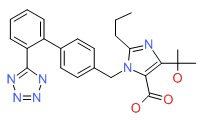NCBI Bookshelf. A service of the National Library of Medicine, National Institutes of Health.
LiverTox: Clinical and Research Information on Drug-Induced Liver Injury [Internet]. Bethesda (MD): National Institute of Diabetes and Digestive and Kidney Diseases; 2012-.

LiverTox: Clinical and Research Information on Drug-Induced Liver Injury [Internet].
Show detailsOVERVIEW
Introduction
Olmesartan is an angiotensin II receptor blocker used in the therapy of hypertension. Olmesartan is associated with a low rate of transient serum aminotransferase elevations, but has yet to be linked to instances of acute liver injury.
Background
Olmesartan (ol" me sar' tan) is an angiotensin II receptor blocker (ARB) used alone or in combination of other agents for therapy of hypertension. Olmesartan inhibits the renin-angiotensin system by blocking the angiotensin II type 1 receptor (AT1), which prevents the vasoconstriction and volume expansion induced by circulating angiotensin II which accounts for its antihypertensive activity. Olmesartan was approved for use in the United States in 2002 and is available in 5, 20 and 40 mg tablets generically under the trade name Benicar. The typical dose of olmesartan in adults in 20 to 40 mg daily in one or two divided doses, and it is used long term. Oral pediatric formulations and suspensions are also available as are fixed combinations with hydrochlorothiazide (Benicar HCT and others) and amlodipine (Azor and others). Side effects are uncommon, but may include headache, dizziness, fatigue, cough, gastrointestinal upset, and fetal toxicity. In addition, olmesartan has been linked to instances of severe sprue-like enteropathy that arises after months or years of therapy and presents with chronic diarrhea, weight loss and abdominal discomfort. Intestinal biopsy shows villous flattening and atrophy, similar to celiac disease. However, symptoms do not improve with a gluten-free diet or corticsteroids, but do resolve promptly upon stopping olmesartan. A similar syndrome has been linked to use of other ARBs including valsartan and losartan.
Hepatotoxicity
Olmesartan has been associated with a low rate of serum aminotransferase elevations (<2%) that in controlled trials was no higher than with placebo therapy. These elevations were transient and rarely required dose modification. No specific instances of clinically apparent acute liver injury have been reported in association with olmesartan therapy, but like other ARBs it may be associated with rare instances of symptomatic hepatotoxicity. With most ARBs, onset of liver injury is within 1 to 8 weeks of starting therapy and the serum enzyme pattern is typically hepatocellular with an acute hepatitis-like clinical syndrome. In some instances, cholestasis has developed which can be prolonged and relapsing, but ARB therapy has not been associated with vanishing bile duct syndrome or chronic liver injury. Immunoallergic manifestations (rash, fever, eosinophilia) are not common, nor is autoantibody formation. Patients who develop severe enteropathy due to olmesartan may have an accompanying fatty liver disease and steatohepatitis with serum aminotransferrase elevations which, like the diarrhea, resolve with stopping therapy.
Likelihood score: D (Possible rare cause of clinically apparent liver injury).
Mechanism of Injury
The cause of the minor serum aminotransferase elevations with olmesartan is not known. Olmesartan does not appear to be metabolized by the liver and has minimal drug-drug interactions. The liver injury that accompanies olmesartan-associated enteropathy is probably due to fatty liver disease caused by diarrhea and malnutrition.
Outcome and Management
The instances of acute liver injury reported with ARB use have been self limited and have not resulted in acute liver failure or chronic liver injury. While corticosteroids have been used in cases of severe cholestasis due to ARBs, their efficacy has not been shown and their use is best avoided. Patients with olmesartan induced liver injury should probably avoid use of other ARBs, although cross sensitivity to liver injury among the members of this class of agents has not been shown.
References on the safety and potential hepatotoxicity of olmesartan are given in the Overview section on the angiotensin II receptor antagonists.
Drug Class: Antihypertensive Agents, Angiotensin II Receptor Antagonists
Other Drugs in the Subclass, Angiotensin II Receptor Antagonists: Azilsartan, Candesartan, Eprosartan, Irbesartan, Losartan, Telmisartan, Valsartan
PRODUCT INFORMATION
REPRESENTATIVE TRADE NAMES
Olmesartan – Benicar®
DRUG CLASS
Angiotensin II Receptor Antagonists
Product labeling at DailyMed, National Library of Medicine, NIH
CHEMICAL FORMULA AND STRUCTURE
| DRUG | CAS REGISTRY NUMBER | MOLECULAR FORMULA | STRUCTURE |
|---|---|---|---|
| Olmesartan | 144689-24-7 | C24-H26-N6-O3 |
 |
- PubChem SubstanceRelated PubChem Substances
- Review Angiotensin II Receptor Antagonists.[LiverTox: Clinical and Researc...]Review Angiotensin II Receptor Antagonists.. LiverTox: Clinical and Research Information on Drug-Induced Liver Injury. 2012
- Review Eprosartan.[LiverTox: Clinical and Researc...]Review Eprosartan.. LiverTox: Clinical and Research Information on Drug-Induced Liver Injury. 2012
- Review Telmisartan.[LiverTox: Clinical and Researc...]Review Telmisartan.. LiverTox: Clinical and Research Information on Drug-Induced Liver Injury. 2012
- Review Azilsartan.[LiverTox: Clinical and Researc...]Review Azilsartan.. LiverTox: Clinical and Research Information on Drug-Induced Liver Injury. 2012
- Antihypertensive, insulin-sensitising and renoprotective effects of a novel, potent and long-acting angiotensin II type 1 receptor blocker, azilsartan medoxomil, in rat and dog models.[Eur J Pharmacol. 2011]Antihypertensive, insulin-sensitising and renoprotective effects of a novel, potent and long-acting angiotensin II type 1 receptor blocker, azilsartan medoxomil, in rat and dog models.Kusumoto K, Igata H, Ojima M, Tsuboi A, Imanishi M, Yamaguchi F, Sakamoto H, Kuroita T, Kawaguchi N, Nishigaki N, et al. Eur J Pharmacol. 2011 Nov 1; 669(1-3):84-93. Epub 2011 Jul 28.
- Olmesartan - LiverToxOlmesartan - LiverTox
Your browsing activity is empty.
Activity recording is turned off.
See more...